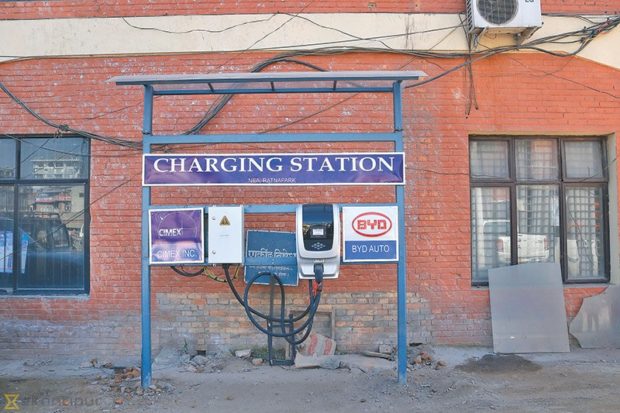
Nepal Electricity Authority has partnered with the Chinese electric motor company, BYD Auto, to set up a charging station for electric cars at Ratnapark in Kathmandu. Post Photo: Anish Regmi
Nepal Electricity Authority (NEA) has established an electric vehicle charging station at Ratnapark in Kathmandu to promote clean, green environment.
According to NEA Deputy Managing Director Sunil Kumar Dhungel, the charging station was set up as a campaign to encourage use of electricity-powered vehicles to control air pollution.
“The charging station has been set up just for a demonstration purpose at the moment. The main purpose behind it is to give out the message that the use of electric vehicles can contribute to clean environment. It will also decrease dependency on fossil fuel and promote use of electricity generated in the country,” he said.
The NEA has partnered with the Chinese electric motor company, BYD Auto, to set up the station.
Dhungel said the NEA was open to the proposal of other companies if they wish to set up similar charging stations in other locations.
“We can encourage those companies who want to set up such stations. The NEA can support them by providing electricity if they wish to operate in different locations,” he said.
The NEA has said that after the completion of Upper Tamakoshi Hydropower Project, the country will have energy surplus situation, especially in monsoon, which can be used to power charging stations in different parts of the country.
In recent times, stakeholders have urged the concerned agencies for creating a conducive environment to facilitate the use of electronic vehicles to address the deteriorating air-quality in major cities.
The Environment-friendly Vehicle and Transport Policy (2014) has been introduced to minimise green house gases emission especially from the transport sector as well as raise share of electric vehicles up to 20 per cent by 2020 in country’s total vehicle number.
However, the electric vehicles have to pass through an unusual test before getting the permission to go on the road.
In absence of any standard method for testing, the efficiency of electric two-wheelers has been examined by its capacity plying on steep roads.
The Vehicle Fitness Test Centre of the Department of Transport Management (DoTM) conducts test for electric vehicles by examining its battery capacity, motor power, energy storing capacity of the battery, mileage after full charge, breaking distance and its capability to go uphill ,among others, according to Ram Chandra Paudel, the centre’s chief.
“Different vehicles have to go through varied tests. But in absence of standard for electric vehicles, we have to conduct test based on different grading of elevation,” said Paudel. “Vehicle manufacturers are asked to follow some criteria set by the government of the country where they are based. We accept those government certified documents as reference for their capacity.”